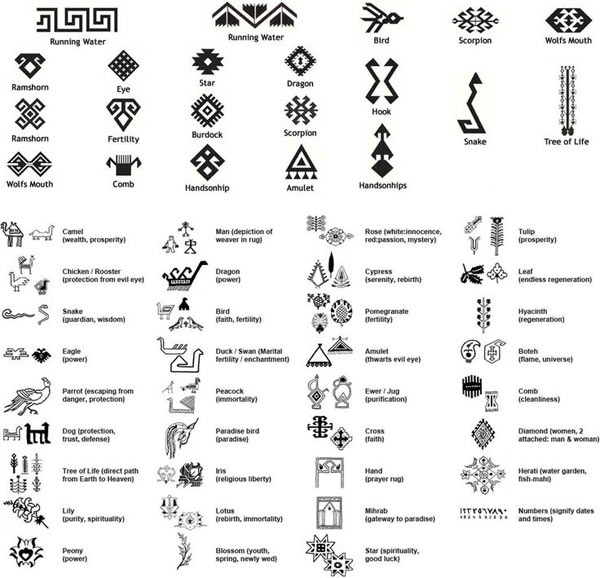
Symbols in Persian Rugs
What makes a Persian rug the finest of them all? Put simply, they are some of the most complex and labor-intensive handmade items in the world, and they have been made the same way dating back to ages BC. They are produced by nomads, shepherds from the Quashqui and Bakhtiari tribes, whose approximately 1.6 million sheep graze on the green slopes of Iran’s Fars Province, which is considered the homeland of Persia. Their wool, comprised of long, tough fibers and shorn only once each year, is ideal for carpet-making and makes these rugs exceedingly durable and long-lasting. The fibers are twisted into threads by the hands of tribal women, then they are colored with dyes made from natural ingredients such as pomegranate, turmeric, acorn shells or green leaves, which are boiled in huge pots with the threads. Once dried, the threads are woven on looms using a trademark single looping knot.
Symbolism in Persian rugs is passed down from generation to generation, and these designs are considered trademarks. They include dense, all-over patterns; rich, striking colors (especially red); and medallion motifs. Each style of Persian rug is named for the town or province in which it was made, and each has distinguishing features. The symbols often were believed to protect the rug’s owner from misfortune. The symbols in Persian rugs may represent historical monuments, scenes from daily life, Islamic buildings, weeping willows or other trees and religious imagery such as the Tree of Life or the Garden of Paradise.
Persian rugs in particular tend to feature four distinct all-over patterns, or motifs. These are:
Herati: This pattern comes from the town of Herat, now in Afghanistan. It consists of a diamond framework and a single floral head, surrounded by outwardly curling acanthus leaves. Sometimes it is referred to as mahi, the Persian word for fish, because the leaves have a sort of fish shape. Herati may be used in medallion or all-over patterns. Herati motifs are thought to symbolize the small fishes that come up just beneath the surface of the water to swim in the full moon's reflection.
Boteh: Along with Herati, Boteh is one of the most commonly found Oriental carpet patterns. It is recognizable because of its resemblance to paisley or a tear drop, with its pear-shaped figure and extending arch of flowers, symbolizing the garden of paradise. Some believe it represents fertility, pine cones, a cypress tree, a leaf, a flame or even a male sperm.
Vase: This pattern name refers to rugs that incorporate a vase or group of vases in their design. Typically, the vase resembles a Grecian urn, with or without handles.
Göl: Uses a repeating octagonal pattern to represent an elephant’s foot. Seen especially in Turkish rugs.
Gül: This floral motif takes its style from the French and usually features one large, dominant flower (often a henna plant) and four surrounding, smaller ones.
Resting eagle: high-mindedness of the spirit
Eagle in flight: good fortune
Leopard: bravery
Cypress tree: life after death
Parrot: escaping from danger, protection
Peony: power
Peacock: immortality or divine protection
Hunting dog: glory and honor
Tree of Life: truth or understanding, a direct path from Earth to Heaven
Lily: purity, spirituality
Paradise Bird: Paradise, or Heaven
Lotus: rebirth, immortality
Lion: power
Iris: religious freedom
Blossom: youth, spring, newlyweds
Tulip: prosperity
Pomegranate: fertility
Amulet: triangular shape thwarts the evil eye
Hyacinth: regeneration
Ewer, or Jug: purification
Comb: cleanliness
Diamond: women (two together represents and man and woman together)
Cross: faith
Hand: prayer rug
Mihrab: gateway to Paradise
Sun: radiant light, lucidity
Star: spirituality, good luck
Numbers: used to signify dates and times

